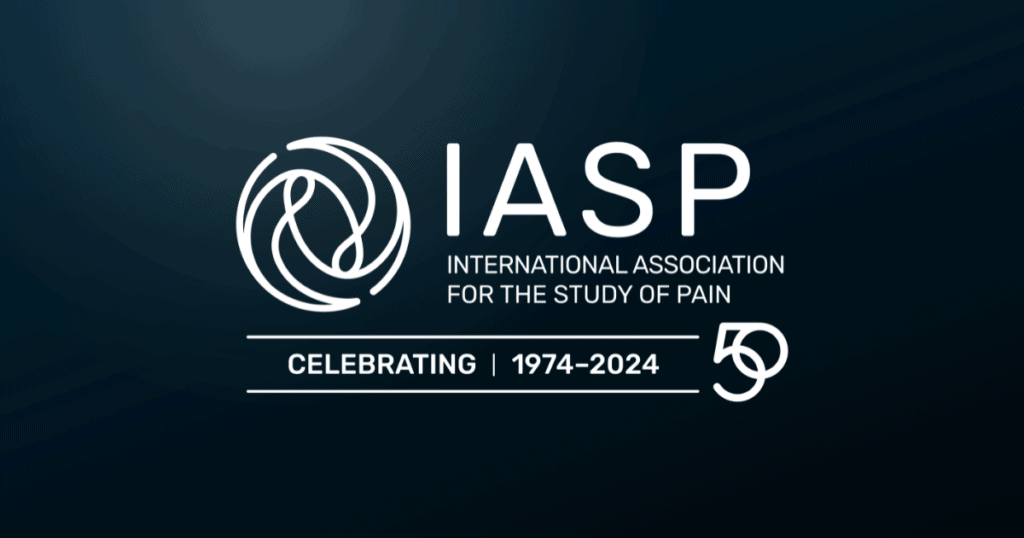Throughout 2024, IASP is celebrating its 50th anniversary, culminating at the 20th World Congress on Pain. As IASP reflects on contributions to the field of pain, it’s immensely proud of the advancements in pain research accomplished by its incredible members.
To highlight (albeit a fraction of) these advancements, IASP has compiled three separate lists of the “Top 10 Most-Cited Papers on Pain,” based upon number of citations and categorized by article type: Primary research papers, “review” papers (i.e., any review, guideline, editorial, commentary, hypothesis exploration, etc.), and methodology papers. Feel free to click any of the titles below to read more!
Primary Research Papers
- Caterina, M.J. et al. (1997) The capsaicin receptor: a heat activated-ion channel in the pain pathway. Nature 389:816-824. [7,386 citations]
- Breivik, H. et al. (2006) Survey of chronic pain in Europe: prevalence, impact on daily life, and treatment. European Journal of Pain 10:287-333. [3,801 citations]
- Caterina, M.J. et al. (2000) Impaired nociception and pain sensation in mice lacking the capsaicin receptor. Science 288:306-313. [3,008 citations]
- Singer, T. et al. (2004) Empathy for pain involves the affective but not sensory components of pain. Science 303:1157-1162. [2,913 citations]
- Tominaga, M. et al. (1998) The cloned capsaicin receptor integrates multiple pain-producing stimuli. Neuron 21:531-543. [2,653 citations]
- Kabat-Zinn, J. (1982) An outpatient program in behavioral medicine for chronic pain patients based on the practice of mindfulness meditation: theoretical considerations and preliminary results. General Hospital Psychiatry 4:33-47. [2,532 citations]
- Rainville, P. et al. (1997) Pain affect encoded in human anterior cingulate but not somatosensory cortex. Science 277:968-971. [2,126 citations]
- Jensen, M.C. et al. (1994) Magnetic resonance imaging of the lumbar spinal in people without back pain. New England Journal of Medicine 331:69-73. [1,952 citations]
- Rosenstiel, A.K. & Keefe, F.J. (1983) The use of coping strategies in chronic low back pain patients: relationship to patient characteristics and current adjustment. PAIN 17:33-44. [1,943 citations]
- Hunskaar, S. & Hole, K. (1987) The formalin test in mice: dissociation between inflammatory and non-inflammatory pain. PAIN 30:103-114. [1,847 citations]
“Review” Papers
- Melzack, R. & Wall, P.D. (1965) Pain mechanisms: a new theory. Science 150:971-979. [7,770 citations]
- Zimmermann, M. (1983) Ethical guidelines for investigations of experimental pain in conscious animals. PAIN 16(2):109-110. [7,032 citations]
- Headache Classification Committee of the International Headache Society. (1988) Classification and diagnostic criteria for headache disorders, cranial neuralgias and facial pain. Cephalalgia 8:1-96. [5,877 citations]*
- Vlaeyen, J.W.S. & Linton, S.J. (2000) Fear-avoidance and its consequences in chronic musculoskeletal pain: a state of the art. PAIN 85:317-332. [3,390 citations]
- Huskisson, E.C. (1974) Measurement of pain. Lancet 304:1127-1131. [3,265 citations]
- Hawker, G.A. et al. (2011) Measures of adult pain: Visual Analog Scale for pain (VAS Pain), Numeric Rating Scale for pain (NRS Pain), McGill Pain Questionnaire (SF-MPQ), Chronic Pain Grade Scale (CPGS), Short Form-36 Bodily Pain Scale (SF-36 BPS), and Measure of Intermittent and Constant Osteoarthritis Pain (ISOAP). Arthritis Care and Research 63, Suppl. 11. [3,098 citations]
- Woolf, C.J. & Salter, M.W. (2000) Neuronal plasticity: increasing the gain in pain. Science 288:1765-1768. [3,072 citations]
- Woolf, C.J. (2011) Central sensitization: implications for the diagnosis and treatment of pain. PAIN 152, Suppl. 3. [2,926 citations]
- Kehlet, H. et al. (2006) Persistent postsurgical pain: risk factors and prevention. Lancet 367:1618-1625. [2,899 citations]
- Basbaum, A.I. et al. (2009) Cellular and molecular mechanisms of pain. Cell 139:267-284. [2,730 citations]
Methodology Papers
- Sullivan, M.J.L. et al. (1995) The Pain Catastrophizing Scale: development and validation. Psychological Assessment 7:524-532. [5,566 citations]
- Melzack, R. (1975) The McGill Pain Questionnaire: major properties and scoring methods. PAIN 1:277-299. [5,495 citations]
- Bennett, G.J. & Xie, Y.-K. (1988) A peripheral mononeuropathy in rat that produces disorders of pain sensation like those seen in man. PAIN 33:87-107. [4,646 citations]
- Cleeland, C.S. & Ryan, K.M. (1994) Pain assessment: global use of the Brief Pain Inventory. Annals of the Academy of Medicine, Singapore 23:129-138. [4,192 citations]
- Farrar, J.T. et al. (2001) Clinical importance of changes in chronic pain intensity measured on an 11-point numerical pain rating scale. PAIN 94:149-158. [4,085 citations]
- Fairbank, J.C.T. et al. (1980) The Oswestry low back pain disability questionnaire. Physiotherapy 66:271-273. [3,712 citations]
- Melzack, R. (1987) The short-form McGill Pain Questionnaire. PAIN 30:191-197. [3,454 citations]
- Roland, M. & Morris, R. (1983) A study of the natural history of back pain: Part 1. Development of a reliable and sensitive measure of disability in low-back pain. Spine 8:141-144. [2,864 citations]
- Dworkin, R.H. et al. (2005) Core outcome measures for chronic pain clinical trials: IMMPACT recommendations. PAIN 113:9-19. [2,863 citations]
- Price, D.D. et al. (1983) The validation of visual analogue scales as ratio scale measures for chronic and experimental pain. PAIN 17:45-56. [2,817 citations]
Which of these papers do you think has had the greatest impact on the field of pain research? Share your thoughts on X/Twitter using #IASP50, and follow us at @IASPpain!
IASP would like to express its gratitude to Jeffrey S. Mogil, PhD (McGill University, Montreal, Canada), for his assistance in compiling these lists and years of service to IASP and its mission.
Methodology: A search of the Scopus database was performed on 26 January 2024. The search term was “pain” within the article title (as a search of the term “pain” as a keyword yielded too many irrelevant hits). The search yielded 293,915 documents, which were sorted by total citations as of the search date. Jeff Mogil reviewed the list to compile three top-10 lists: 1) Primary Research Papers, 2) “Review” Papers, and 3) Methodology Papers. The number of citations for each paper is bracketed. Note: Of the 293,915 documents, only 190 of them (i.e., 0.06%) have garnered 1,000 or more citations.
*Now referred to as The International Classification of Headache Disorders, 1st Edition.


